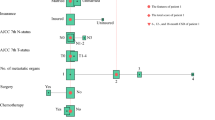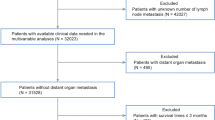Abstract
Objective
Information on prognosis for patients with cutaneous melanoma after locoregional or distant recurrence is sparse and controversial. The aim of this study was to analyze factors influencing outcome after the development of a first relapse.
Methods
Information was extracted from the Sydney Melanoma Unit database for 873 melanoma patients with American Joint Committee on Cancer (AJCC) Stage I and II disease treated between 1960 and 2002 who relapsed following treatment of their primary melanoma. Clinical and pathologic factors predicting survival were analyzed using the Cox proportional hazards regression model.
Results
Initial presentation of recurrence was local: 95 patients (10.9%), in transit: 86 patients (9.9%), regional lymph node: 300 patients (34.4%), and distant: 392 patients (44.9%). Independent prognostic factors for survival of the 481 patients with only locoregional recurrence were type of recurrence, primary tumor ulceration, and patient age. Predictors for longer survival in the 392 patients with distant metastasis at the time of first presentation with recurrence were lung vs other sites and diagnosis of relapse after 1990 compared with diagnosis before 1980.
Conclusions
The type of recurrence is the most important prognostic factor in melanoma patients who relapse. Primary tumor ulceration is the most important pathologic predictor. The results of this study suggest that management of distant metastases may have improved over the last 25 years, but many confounders and improved staging techniques make assessment of this unreliable.



Similar content being viewed by others
References
Eigentler TK, Caroli UM, Radny P, et al. Palliative therapy of disseminated malignant melanoma: a systematic review of 41 randomised clinical trials. Lancet Oncol 2003;4:748–59
Markowitz JS, Cosimi LA, Carey RW, et al. Prognosis after initial recurrence of cutaneous melanoma. Arch Surg 1991;126:703–7
Roses DF, Karp NS, Oratz R, et al. Survival with regional and distant metastases from cutaneous malignant melanoma. Surg Gynecol Obstet 1991;172:262–8
Soong SJ, Harrison RA, McCarthy WH, et al. Factors affecting survival following local, regional, or distant recurrence from localized melanoma. J Surg Oncol 1998;67:228–33
Cohn-Cedermark G, Mansson-Brahme E, Rutqvist LE, et al. Metastatic patterns, clinical outcome, and malignant phenotype in malignant cutaneous melanoma. Acta Oncol 1999;38:549–57
Meier F, Will S, Ellwanger U, et al. Metastatic pathways and time courses in the orderly progression of cutaneous melanoma. Br J Dermatol 2002;147:62–70
Brand CU, Ellwanger U, Stroebel W, et al. Prolonged survival of 2 years or longer for patients with disseminated melanoma. An analysis of related prognostic factors. Cancer 1997;79:2345–53
Karakousis CP, Velez A, Driscoll DL, et al. Metastasectomy in malignant melanoma. Surgery 1994;115:295–302
Buzzell RA, Zitelli JA. Favorable prognostic factors in recurrent and metastatic melanoma. J Am Acad Dermatol 1996;34:798–803
Crowley NJ, Seigler HF. Relationship between disease-free interval and survival in patients with recurrent melanoma. Arch Surg 1992;127:1303–8
Essner R, Lee JH, Wanek LA, et al. Contemporary surgical treatment of advanced-stage melanoma. Arch Surg 2004;139:961–6
Balch CM, Buzaid AC, Soong SJ, et al. Final version of the American Joint Committee on Cancer staging system for cutaneous melanoma. J Clin Oncol 2001;19:3635–48
Balch CM, Soong SJ, Gershenwald JE, et al. Prognostic factors analysis of 17,600 melanoma patients: validation of the American Joint Committee on Cancer melanoma staging system. J Clin Oncol 2001;19:3622–34
Francken AB, Shaw HM, Thompson JF, et al. The prognostic importance of tumor mitotic rate confirmed in 1317 patients with primary cutaneous melanoma and long follow-up. Ann Surg Oncol 2004;11:426–33
Azzola MF, Shaw HM, Thompson JF, et al. Tumor mitotic rate is a more powerful prognostic indicator than ulceration in patients with primary cutaneous melanoma: an analysis of 3661 patients from a single center. Cancer 2003;97:1488–98
Mooney MM, Mettlin C, Michalek AM, et al. Life-long screening of patients with intermediate-thickness cutaneous melanoma for asymptomatic pulmonary recurrences: a cost-effectiveness analysis. Cancer 1997;80:1052–64
Ollila DW. Complete metastasectomy in patients with stage IV metastatic melanoma. Lancet Oncol 2006;7:919–24
Petersen RP, Hanish SI, Haney JC, et al. Improved survival with pulmonary metastasectomy: an analysis of 1720 patients with pulmonary metastatic melanoma. J Thorac Cardiovasc Surg 2007;133:104–10
Pidhorecky I, Lee RJ, Proulx G, et al. Risk factors for nodal recurrence after lymphadenectomy for melanoma. Ann Surg Oncol 2001;8:109–15
Kretschmer L, Preusser KP, Marsch WC, et al. Prognostic factors of overall survival in patients with delayed lymph node dissection for cutaneous malignant melanoma. Melanoma Res 2000;10:483–9
Konstadoulakis MM, Messaris E, Zografos G, et al. Common prognostic factors for stage III melanoma patients and for stage I and II melanoma patients with recurrence to their regional lymph nodes. Melanoma Res 2002;12:357–64
Hoyt DJ, Fisher SR. Survival following recurrent malignant melanoma of the head and neck. Laryngoscope 1989;99:586–9
Sanki A, Kam PC, Thompson JF. Long-term results of hyperthermic, isolated limb perfusion for melanoma: a reflection of tumor biology. Ann Surg 2007;245:591–6
Karakousis CP, Balch CM, Urist MM, et al. Local recurrence in malignant melanoma: long-term results of the multi-institutional randomized surgical trial. Ann Surg Oncol 1996;3:446–52
Gadd MA, Coit DG. Recurrence patterns and outcome in 1019 patients undergoing axillary or inguinal lymphadenectomy for melanoma. Arch Surg 1992;127:1412–6
Balch CM, Soong S, Ross MI, et al. Long-term results of a multi-institutional randomized trial comparing prognostic factors and surgical results for intermediate thickness melanomas (1.0 to 4.0 mm). Intergroup Melanoma Surgical Trial. Ann Surg Oncol 2000;7:87–97
Cascinelli N, Morabito A, Santinami M, et al. Immediate or delayed dissection of regional nodes in patients with melanoma of the trunk: a randomised trial. WHO Melanoma Programme. Lancet 1998;351:793–6
Acknowledgments
Anne Brecht Francken was a Sydney Melanoma Unit and Groningen University Medical Center Research Fellow supported by: Stichting VSB Fonds, Stichting Dr Hendrik Muller’s Vaderlandsch Fonds, Stichting Fonds Doctor, Catherine van Tussenbroek- Nell Ongerboer Fonds, Stichting Groninger Universiteits Fonds, Stichting De Korintiers, Nederlandse Kankerbestrijding—Koningin Wilhemina Fonds, Marco Polo Fonds, The Melanoma Foundation of the University of Sydney, Integraal Kankercentrum Noord-Nederland.
Author information
Authors and Affiliations
Corresponding author
Rights and permissions
About this article
Cite this article
Francken, A.B., Accortt, N.A., Shaw, H.M. et al. Prognosis and Determinants of Outcome Following Locoregional or Distant Recurrence in Patients with Cutaneous Melanoma. Ann Surg Oncol 15, 1476–1484 (2008). https://doi.org/10.1245/s10434-007-9717-9
Received:
Revised:
Accepted:
Published:
Issue Date:
DOI: https://doi.org/10.1245/s10434-007-9717-9




